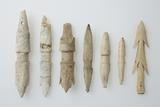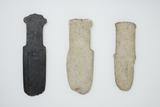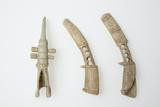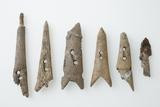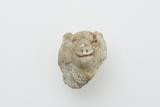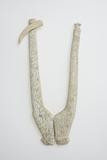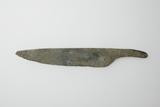銛頭
掲載No.:36
出土遺跡:(左から1・3)トコロチャシ跡遺跡(史跡常呂遺跡)1号竪穴表層、(左5・6)同住居外骨塚、(左2)同オホーツク地点7b号竪穴骨塚b、(左7)同9c号竪穴床面、(左4)栄浦第二遺跡7号竪穴表土・埋土
時代:オホーツク文化(後期)
年代:紀元8-9世紀
所蔵:常呂実習施設
報告書:(左から1・3)『オホーツク海沿岸・知床半島の遺跡 下巻』Fig.39-8・7、(左5・6)『トコロチャシ跡遺跡』Fig.14-6・7、(左2・7)『トコロチャシ跡遺跡オホーツク地点』Fig.49-43・同126-1、(左4)『常呂』Fig.126-1
解説:オホーツク文化では骨角器が質・量ともに豊富にみられる。銛の先端の部品である銛頭はその代表で、様々な形態のものがある。写真の左4〜6はこのまま、左1〜3と7は先端に鏃を装着して柄に固定され、海獣や大型魚類などの猟に用いられた。
No.:36
Site:(1st and 3rd from the left)Tokoro-chashi site: from the fill of Pit House 1, (5th and 6th)Tokoro-chashi site: Bone Mound, (2nd) Tokoro-chashi site Okhotsk Locality: from Bone Mound b of Pit House 7b, (7th)Tokoro-chashi site Okhotsk Locality: on the floor of Pit House 9c, (4th)Sakaeura Ⅱ site: from the fill of Pit House 7
Period:Late stage of Okhotsk culture
Date:8-9th century
Possessor:Tokoro Research Laboratory
Comment:Bone and antler implements from the Okhotsk culture are rich in their quality and quantity. The harpoon head, which is part of a harpoon, is a representative example, and it comes in many forms. The samples in the figure were hafted, and an arrowhead was attached to the first three and the seventh samples (counting from the left). All of them were used for hunting sea mammals or large fish.
-
部局人文社会系研究科・文学部
-
所蔵者東京大学大学院人文社会系研究科附属北海文化研究常呂実習施設
-
提供者東京大学文学部「人文学における国際的地域・社会連携の推進」プログラム(東京大学未来社会協創推進本部登録プロジェクト)
-
メディア(画像等)利用条件http://www.l.u-tokyo.ac.jp/t_collection/jp/explanation3.html
-
メタデータ利用条件http://creativecommons.org/licenses/by/4.0/

コレクション名
-
常呂川下流域の考古資料コレクション
常呂実習施設が所蔵する考古資料の公開サイトです。常呂川下流域の遺跡から出土した土器・石器・骨角器等を画像で公開しています。
